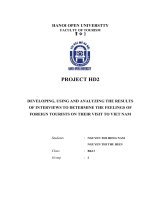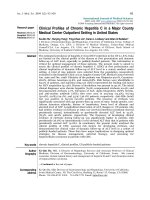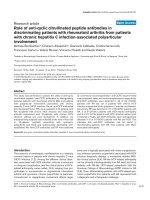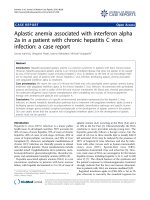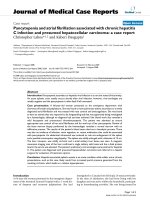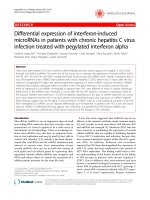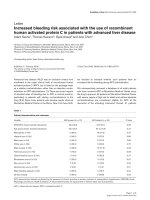Factors associated with the quality of life of patients with chronic hepatitis c in viet tiep hospital, hai phong city, viet nam
Bạn đang xem bản rút gọn của tài liệu. Xem và tải ngay bản đầy đủ của tài liệu tại đây (2.33 MB, 92 trang )
Institut de la Francophonie
pour la MédecineTropicale
(IFMT)
Vientiane, RDP LAO
Master in Tropical Medicine and International Health
17th Promotion 2015 – 2017
Master thesis
Factors associated with the Quality of Life of patients with chronic
hepatitis C in Viet Tiep Hospital, Hai Phong City, Viet Nam
Author: Duong Xuan TRAN
Supervisor: Vinh HAI VU M.D., Ph.D.
Co-supervisor: Prof. Daniel REINHARZ
Rapporteur: Prof. Virak KHIEU
Vientiane, 2017
Duong Xuan TRAN – Protocol Quality of life – HCV
Page 1
BIOGRAPHY
First and last name: Duong Xuan TRAN
Date of birth: 15 December 1985
Place of birth: Thai Binh province, Viet Nam
Nationality: Vietnamese
Bachelor's degree: Medicine, Thai Binh University of Medical and Pharmacy
Personal interest: Infectious diseases and quality of life
Duong Xuan TRAN – Protocol Quality of life – HCV
Page 2
TITLE OF RESEARCH
Factors associated with the Quality of Life of patients with chronic
hepatitis C in Viet Tiep Hospital, Hai Phong City, Viet Nam
TITRE DE MÉMOIRE
Facteurs associés à la qualité de vie des patients atteints d'hépatite
chronique C au Viet Tiep Hôpital, Hai Phong, Viet Nam
Presented by: Duong Xuan TRAN
24 August 2017, Vientiane, Lao PDR
Under the supervision of Vinh HAI VU M.D., Ph.D.
The president of the jury: Prof. Duangdao SOUK ALOUN, of the University of Health
Sciences, Lao PDR
Members of the Jury
Prof. Boungnong
BOUPHA
University of Health Sciences, Lao PDR
Prof. Virak KHIEU
National Center for Entomology, Parasitology, and Malaria Control,
Cambodia
Prof. Khue MINH
PHAM
Prof. Mayfong
MAYXAY
University of Medicine and Pharmacy of Hai Phong, Viet Nam
University of Health Sciences, Lao PDR
Prof. Paul NEWTON
Lao-Oxford Medical Research Wellcome Trust Unit, Lao PDR
Prof. Niranh
POUMINDR
University of Health Sciences, Lao PDR
Rapporter: Prof. Virak KHIEU
Duong Xuan TRAN – Protocol Quality of life – HCV
Page 3
ACKNOWLEDGEMENT
First of all, I would like to express my sincere feelings to my parents who have supported me all
through my life.
I am also very thankful to:
Prof. Daniel REINHARZ, Director of IFMT, Professor of the University of Laval and supervisor
of my thesis. Being his student was very fortunate for me and a great honor. With him, my brain
was free, my interesting ideas came out and my quality of life increased. I am deeply grateful for
his remarkable efforts, patience, conscientiousness and especially his love for me and IFMT.
Dr. VU Hai Vinh, vice chief of the Infectious Diseases Department and infectious diseases wardViet Tiep Hospital, co-supervisor. I thank him for his help, experience and concern. Without
him, I do not know how I would have conducted this study.
Department of Infectious Diseases, Viet Tiep Hospital and all the staffs there. They helped me
enthusiastically in collecting data.
Prof. Michel STROBEL, Professor of Pathology and Infectious Diseases, for his passion for
teaching and his medical professionalism.
Dr. Phetsavanh CHANTHAVILAY who helped me analyze complicated data. Without him, I do
not know what I would have done.
Percy AARON, English teacher, who I got many benefits in learning English and for his
intelligent questions. I thank him for his patience and efforts in revising my huge mistakes.
Aline SEBIE, French teacher, who helped me improve my French with enthusiasm.
My family, especially my wife and my daughter, who were burdened and greatly inconvenienced
by my not being there for them.
Thai Binh University of Medicine and Pharmacy, and the Department of Infectious Diseases for
giving me permission to join and finish this course and those who took over my responsibilities
there during my absence.
I would also like to thank deeply the Agence Universitaire de la Francophonie (AUF) and all the
IFMT staff who warmly supported all my activities.
Last but not least, I would also like to express my thanks and appreciation to all the terrific
friends I made in P17. They helped me overcome difficulties during my study with so much
kindness, patience and fun. They will forever be part of my family.
Duong Xuan TRAN – Protocol Quality of life – HCV
Page 4
Contents
I. INTRODUCTION ..................................................................................................................... 13
II. REVIEW OF LITERATURE................................................................................................... 13
2.1 Hepatitis C virus: characteristics ........................................................................................ 13
Figure 1: Global distribution of genotypes of HCV ................................................................. 14
2.2. HIV co-infected with HCV ............................................................................................... 14
2.2 Epidemiology and burden of disease ................................................................................. 15
Figure 2: Best estimates of prevalence of hepatitis C virus (HCV) co-infection in four
population samples ................................................................................................................... 16
2.3 Prevention of hepatitis C and HIV ..................................................................................... 16
2.3 Clinical evolution of a hepatitis infection .......................................................................... 16
2.4 Treatment of hepatitis C ..................................................................................................... 16
2.5 Quality of Life .................................................................................................................... 16
2.5.1 Generalities regarding QoL ........................................................................................ 16
2.5.2 QoL in hepatitis patients. ............................................................................................ 17
2.6 Hepatitis C in Viet Nam ..................................................................................................... 18
III. RESEARCH QUESTION AND OBJECTIVES OF STUDY ................................................ 19
3.1. Research question .............................................................................................................. 19
3.2. Objectives of research ....................................................................................................... 19
3.3. Conceptual framework ...................................................................................................... 19
Figure 3: Conceptual framework of the determinants of the QoL of patients with chronic
hepatitis C................................................................................................................................. 20
IV. METHODOLOGY ................................................................................................................. 20
4.1. Study design ...................................................................................................................... 20
4.2. Study location .................................................................................................................... 20
4.3. Data collection period ....................................................................................................... 21
4.4. Population of study............................................................................................................ 21
4.5 Sample size......................................................................................................................... 21
4.6. Sources of information ...................................................................................................... 21
4.7. Procedure ........................................................................................................................... 22
4.7.1. Translation of the specific QoL instrument ............................................................... 22
4.7.2. Data collection ........................................................................................................... 22
4.8. Data analyses ..................................................................................................................... 23
4.9. Ethical considerations ....................................................................................................... 24
V. RESULTS ................................................................................................................................ 24
5.1 Descriptive analyses ........................................................................................................... 24
Table 1: Socio-demographic characteristics of the participants............................................... 25
Table 2: Health-related factor characteristics........................................................................... 26
Table 3: Treatment-related factors ........................................................................................... 27
Table 4: Social support and lowest CD4 in HIV group ........................................................... 27
Table 5: Score of Chronic Hepatitis Disease Questionnaire .................................................... 27
Table 6: Score of the 36-Item Short Form Health Survey (SF-36) .......................................... 28
5.2 Bivariate analyses ............................................................................................................... 28
5.2.1. Chronic Liver Disease Questionnaire (CLDQ) ......................................................... 28
Duong Xuan TRAN – Protocol Quality of life – HCV
Page 5
Table 7: Association between the total score of Chronic Liver Disease Questionnaire and
independent variables ............................................................................................................... 29
5.2.2 SF-36 Physical Component Summary (PCS) ............................................................. 30
Table 8: Association between the SF-36 PCS score and potential independent variables ...... 30
5.2.3 SF-36 Mental Component Summary (MCS) .............................................................. 31
Table 9: Association between the total SF-36 MCS score and independent variables ............ 31
5.2.4 SF-36 General Health (GH) Dimension ..................................................................... 32
Table 10: Association between the SF-36 GH score and potential independent variables ...... 33
5.2.5 SF-36 Physical Functioning (PF) Dimension ............................................................. 33
Table 11: Association between the SF-36 PF score and independent variables ...................... 34
5.2.6 SF-36 Role Physical (RP) Dimension ........................................................................ 35
Table 12: Association between the SF-36 RP score and independent variables ...................... 35
5.2.7 SF-36 Bodily Pain Dimension (BP) ........................................................................... 37
Table 13: Association between the SF-36 BP score and independent variables ...................... 37
5.2.8 SF-36 Vitality Dimension (VT) .................................................................................. 38
Table 14: Association between the SF-36 VT score and potential independent variables ...... 39
5.2.9 SF-36 Social Functioning Dimension (SF) ................................................................ 39
Table 15: Association between the SF-36 SF score and independent variables ...................... 40
5.2.10 SF-36 Role Emotional Dimension (RE) ................................................................... 41
Table 16: Association between SF-36 RE and independent variables ..................................... 42
5.2.11 SF-36 Mental Health Dimension (MH) .................................................................... 43
Table 17: Association between the SF-36 MH score and independent variables .................... 43
5.3 Multivariate analyses.......................................................................................................... 45
5.3.1. Chronic Liver Disease Questionnaire (CLDQ) ......................................................... 45
Table 18: Multivariate analysis of factors associated with CLDQ .......................................... 45
Logistic regression ................................................................................................................... 45
5.3.2. SF-36 Physical Component Summary (PCS) ............................................................ 46
Table 19: Multivariate analysis of factors associated with PCS .............................................. 46
Linear regression ...................................................................................................................... 46
5.3.3. SF-36 Mental Component Summary (MCS) ............................................................. 47
Table 20: Multivariate analysis of factors associated with MCS ............................................. 47
5.3.4 SF-36 General Health Dimension (GH) ..................................................................... 48
Table 21: Multivariate analysis of factors associated with GH ............................................... 48
5.3.5 SF-36 Physical Function Dimension (PF) .................................................................. 49
Table 22: Multivariate analysis of factors associated with PF ................................................. 49
5.3.6 SF-36 Role Physical Dimension (RP) ........................................................................ 49
Table 23: Multivariate analysis of factors associated with RP ................................................ 50
5.3.7 SF-36 Bodily Pain Dimension (BP) ........................................................................... 50
Table 24: Multivariate analysis of factors associated with BP ................................................ 51
5.3.8 SF-36 Vitality Dimension (VT) .................................................................................. 51
Table 25: Multivariate analysis of factors associated with VT ................................................ 52
5.3.9 SF-36 Social Functioning Dimension (SF) ................................................................ 52
Table 26: Multivariate analysis of factors associated with SF ................................................. 53
5.3.10 SF-36 Role Emotional Dimension (RE) ................................................................... 53
Table 27: Multivariate analysis of factors associated with RE ................................................ 54
5.3.11 SF-36 Mental Health Dimension (MH) .................................................................... 54
Duong Xuan TRAN – Protocol Quality of life – HCV
Page 6
Table 28: Multivariate analysis of factors associated with MH ............................................... 55
Table 29: Summary of association between factors and QoL in final models ......................... 56
VI. DISCUSSION ......................................................................................................................... 57
VII. LIMITATIONS ..................................................................................................................... 59
VIII. RECOMMENDATIONS ..................................................................................................... 59
ANNEXES .................................................................................................................................... 64
Annexe 1: non-commercial license agreement of SF-36 ......................................................... 64
Annex 2: English version informed consent form ................................................................... 65
Annex 3: Vietnamese version informed consent form ............................................................. 66
Annex 4: total english version of questions ............................................................................. 67
Annex 5: Vietnameses version of total questions .................................................................... 80
LIST OF TABLES
Table 1: Socio-demographic characteristics of the participants ................................................... 25
Table 2: Health-related factor characteristics ............................................................................... 26
Table 3: Treatment-related factors ................................................................................................ 27
Table 4: Social support and lowest CD4 in HIV group ................................................................ 27
Table 5: Score of Chronic Hepatitis Disease Questionnaire ......................................................... 27
Table 6: Score of the 36-Item Short Form Health Survey (SF-36)............................................... 28
Table 7: Association between the total score of Chronic Liver Disease Questionnaire and
independent variables.................................................................................................................... 29
Table 8: Association between the SF-36 PCS score and potential independent variables ........... 30
Table 9: Association between the total SF-36 MCS score and independent variables ................. 31
Table 10: Association between the SF-36 GH score and potential independent variables .......... 33
Table 11: Association between the SF-36 PF score and independent variables ........................... 34
Table 12: Association between the SF-36 RP score and independent variables .......................... 35
Table 13: Association between the SF-36 BP score and independent variables .......................... 37
Table 14: Association between the SF-36 VT score and potential independent variables ........... 39
Table 15: Association between the SF-36 SF score and independent variables ........................... 40
Table 16: Association between SF-36 RE and independent variables ......................................... 42
Table 17: Association between the SF-36 MH score and independent variables ......................... 43
Table 18: Multivariate analysis of factors associated with CLDQ ............................................... 45
Table 19: Multivariate analysis of factors associated with PCS ................................................... 46
Table 20: Multivariate analysis of factors associated with MCS ................................................. 47
Table 21: Multivariate analysis of factors associated with GH .................................................... 48
Table 22: Multivariate analysis of factors associated with PF ..................................................... 49
Table 23: Multivariate analysis of factors associated with RP ..................................................... 50
Table 24: Multivariate analysis of factors associated with BP ..................................................... 51
Table 25: Multivariate analysis of factors associated with VT..................................................... 52
Table 26: Multivariate analysis of factors associated with SF ..................................................... 53
Table 27: Multivariate analysis of factors associated with RE ..................................................... 54
Table 28: Multivariate analysis of factors associated with MH ................................................... 55
Table 29: Summary of association between factors and QoL in final models ............................. 56
Duong Xuan TRAN – Protocol Quality of life – HCV
Page 7
LIST OF FIGURES
Figure 1: Global distribution of genotypes of HCV ..................................................................... 14
Figure 2:Best estimates of prevalence of hepatitis C virus (HCV) co-infection in four population
samples .......................................................................................................................................... 16
Figure 3: Conceptual framework of the determinants of the QoL of patients with chronic
hepatitis C ..................................................................................................................................... 20
Duong Xuan TRAN – Protocol Quality of life – HCV
Page 8
ABBREVIATIONS
QoL: Quality of life
HCV: Hepatitis C virus
CLDQ: Chronic Liver Disease Questionnaire
SF-36: Medical Outcome Study Short Form 36-Item Health Survey
HIV: Human Immunodeficiency Virus
CD4: Cluster Difference 4
RNA: ribonucleic acid
ALT: alanine aminotransferase
ART: antiretroviral therapies
PWID: people who inject drugs
WHO: World Health Organization
HQLQ: Hepatitis Quality of Life Questionnaire
LDQOL: The liver disease Quality of Life Questionnaire
LDSI: Liver Disease Symptom Index
IDUs: injecting drug users
DAAs: Direct-acting antivirals
MoH: Ministry of Health
TM: trademark
PCS: Physical Component Summary
MCS: Mental Component Summary
GH: General Health
PF: Physical Function
RP: Role Physical
BP: Bodily Pain
VT: Vitality
SF: Social Functioning
RE: Role Emotional
MH: Mental Health
Duong Xuan TRAN – Protocol Quality of life – HCV
Page 9
Factors associated with the Quality of Life of patients with chronic hepatitis C in Viet Tiep
Hospital, Hai Phong City, Viet Nam
Abstract
Problem: improving the quality of life (QoL) of patients with chronic hepatitis C is a
fundamental objective of healthcare. Nothing is known about this topic in Viet Nam.
Objective: The aim of this research is to evaluate the QoL of patients with chronic hepatitis C,
and some of its determinants.
Material and Methods: A cross-sectional study was conducted on a sample of 128 HCV
patients. Two questionnaires were used to measure QoL: SF-36 and the Chronic Liver Disease
Questionnaire. Multiple regressions were performed to identify potential determinants of the
QoL.
Results: Liver condition; gender; age; and a diagnosis done more than 3 years ago were found to
negatively affect QoL. In contrast, having enough financial resources; having a higher level of
education; being aware of the possible outcomes of the disease; being treated for hepatitis and
receiving new generation drugs affect positively the QoL.
Conclusion: improving QoL of patients with chronic hepatitis C is feasible. Making patients
more knowledgeable about hepatitis C and prioritizing access to new generation anti-HCV drugs
are key means for this improvement.
Keywords: quality of life, hepatitis C virus, SF-36, Chronic Liver Disease Questionnaire
(CLDQ), Viet Nam.
Duong Xuan TRAN – Protocol Quality of life – HCV
Page 10
Facteurs associés à la qualité de vie des patients atteints d'hépatite chronique C au Viet
Tiep Hôpital, Hai Phong, Viet Nam
Résumé
Problématiques: L’amélioration de la qualité de vie (QV) des patients atteints d'hépatite virale
chronique C (HVC) représente un objectif fondamental des soins dispensés à ces patients. Peu de
données sont disponibles sur ce sujet au Viet Nam.
Objectif: Cette étude vise à évaluer la qualité de vie des patients atteints d'hépatite C chronique,
et de ses déterminants.
Matériel et méthodes: Une étude transversale a été réalisée sur un échantillon de 128 patients
atteints de HVC. Deux questionnaires ont été utilisés pour la mesure de la qualité de vie: le SF36 et le questionnaire sur les maladies hépatiques chronique. Des analyses de régression multiple
ont été réalisées pour identifier les déterminants potentiels de la qualité de vie.
Résultats: L’état du foie; le sexe; l'âge et un diagnostic connu depuis plus de 3 ans ont
négativement affectés la QV des patients. En revanche, avoir suffisamment de ressources
financières; ayant un niveau d'éducation élevé; être au courant des conséquences possibles de la
maladie; être traités et recevant des médicaments de nouvelle génération contre l’hépatite C ont
eu un effet positif sur la qualité de vie.
Conclusion: l'amélioration de la qualité de vie des patients atteints d'hépatite chronique C est
possible. Une amélioration de la connaissance sur l'hépatite C et à l'accès aux médicaments
anti-VHC de nouvelle génération représentent des moyens clés pour améliorer leur qualité de
vie.
Mots-clés: qualité de vie, virus de l'hépatite C, SF-36, Questionnaire sur les maladies hépatiques
chroniques (CLDQ), Viet Nam.
Duong Xuan TRAN – Protocol Quality of life – HCV
Page 11
Những yếu tố liên quan đến chất lượng cuộc sống của bệnh nhân viêm gan C mạn tính ở
bệnh viện Việt Tiệp, Hải Phịng, Việt Nam
Tóm tắt
Vấn đề: cải thiện chất lượng cuộc sống của bệnh nhân viêm gan C mạn tính là mục tiêu cơ bản
của điều trị. Chưa có thơng tin cụ thể về chủ đề này ở Việt Nam.
Mục tiêu: Mục tiêu của nghiên cứu này là lượng giá chất lượng cuộc sống của bệnh nhân viêm
gan C mạn tính và những yếu tố của nó.
Phương pháp và công cụ: Nghiên cứu cắt ngang đã được tiến hành trên mẫu 128 bệnh nhân
viêm gan C. Hai bảng câu hỏi đã được sử dụng để tính chất lượng cuộc sống: SF-36 và bảng câu
hỏi bệnh viêm gan mạn. Hồi quy đa biến được sử dụng để xác định các yếu tố có khả năng quyết
định chất lượng cuộc sống.
Kết quả: Tình trạng lá gan; giới tính; tuổi và được chẩn đoán hơn 3 năm đã được xác định tác
động âm tính tới chất lượng cuộc sống. Ngược lại, có đủ nguồn lực tài chính; giáo dục tốt hơn;
biết về các hậu quả của bệnh; điều trị và điều trị bằng thế hệ thuốc mới tác động dương tính lên
chất lượng cuộc sống.
Kết luận: cải thiện chất lượng cuộc sống của bệnh nhân viêm gan C mạn tính là khả thi. Làm
tăng sự hiểu biết của bệnh nhân về viêm gan C và ưu tiên tiếp cận với thuốc điều trị mới là chìa
khóa.
Từ khóa: Chất lượng cuộc sống, viêm gan virus C, SF-36, bảng câu hỏi viêm gan mạn, Viet Nam
Duong Xuan TRAN – Protocol Quality of life – HCV
Page 12
I. INTRODUCTION
Addressing Quality of Life (QoL) should be the major objective of any treatment,
particularly in case of chronic diseases, as this affects the well-being of individuals often during
a long proportion of their lives. Health professionals have therefore a responsibility to
understand what affects the QoL of the patients.
Hepatitis C is a disease prevalent worldwide. When it becomes chronic, it can profoundly
affect the QoL of the patient, as it is frequently accompanied by fatigue, depression, malaise and
cognitive impairment.
No study has been done in Viet Nam on the QoL in hepatitis C patients. Therefore, we do
not know how to complement medical treatment with interventions that might improve the QoL
of HCV affected patients.
II. REVIEW OF LITERATURE
2.1 Hepatitis C virus: characteristics
HCV is a small enveloped RNA virus belonging to the family Flaviviridae and
genus hepacivirus. HCV genomic RNA is single-stranded with positive polarity, which is
packaged by core protein and enveloped by a lipid bilayer containing two viral glycoproteins (E1
and E2) to form the virion (1). Despite the nucleotide sequence divergence among genotypes, all
currently recognized HCV genotypes are hepatotropic and pathogenic.
The distribution of HCV genotypes and sub genotypes varies substantially in different parts
of the world (Figure 1). According to a recent review, genotype 1 is the most common,
accounting for 46.2% of all HCV infections, followed by genotype 3 (30.1%). The diversity of
genotypes also varies; the highest diversity is observed in China and Southeast Asia, while in
some countries, such as Egypt and Mongolia, almost all HCV infections are due to a single
genotype (2).
Duong Xuan TRAN – Protocol Quality of life – HCV
Page 13
Figure 1: Global distribution of genotypes of HCV
The purpose of diagnosis of viral infection is to allow infected persons to be identified and
treated. Thus, diagnosis of viral infection is important to prevent disease progression and viral
spread. The majority of primary HCV-infected patients are asymptomatic. Thus, symptoms
cannot be used as specific indicators of HCV infection. HCV viremia can still exist despite a
normal serum alanine aminotransferase (ALT) level. Therefore, virological methods, rather than
ALT levels are used to diagnose HCV infection(3).
2.2. HIV co-infected with HCV
HIV is a member of the genus Lentivirus, part of the family Retroviridae. There are two
types: HIV-1 and HIV-2. HIV-1 is the virus that was initially discovered. It is more virulent,
more infective(4), and is the cause of the majority of HIV infections globally. The lower
infectivity of HIV-2 implies that fewer of those exposed to HIV-2 will be infected per exposure.
Due to its relatively poor capacity for transmission, HIV-2 is largely confined to West Africa (5).
It is roughly spherical with a diameter of about 120 nm, around 60 times smaller than a red
blood cell . It is composed of two copies of positive single-stranded RNA that codes for the
virus's nine genes enclosed by a conical capsid composed of 2 000 copies of the viral protein p24
(6). The single-stranded RNA is tightly bound to nucleocapsid proteins, p7, and enzymes needed
for the development of the virion such as reverse transcriptase, proteases, ribonuclease
and integrase. A matrix composed of the viral protein p17 surrounds the capsid ensuring the
integrity of the virion particle (6).
The interaction between HIV and HCV co-infection affects the transmission and natural
history of HCV infection. The transmission efficiency of HCV increases in the presence of HIV
infection, with the perinatal transmission risk doubling in HIV-infected mothers (7,8). People
Duong Xuan TRAN – Protocol Quality of life – HCV
Page 14
living with HIV without treatment are less likely to spontaneously clear HCV infection, have
higher HCV viral loads, and experience more rapid HCV disease progression than those without
HIV infection (9). Although ART improves outcomes in HCV co-infected patients, with
decreased HCV-related mortality(10), HCV co-infection might also complicate HIV treatment,
with some evidence suggesting an increased risk of drug related hepatoxicity in those receiving
ART.12. There is an absence of consistent data regarding the effect of HCV co-infection on HIV
progression (8,10,11).
2.2 Epidemiology and burden of disease
HIV and hepatitis C virus (HCV) infection are major global public health concerns, with
overlapping modes of transmission and affected populations. Globally, the HIV population is
estimated at about 36.7 million, with 2.1 million new cases every year, and 1.6 million deaths
(12). Despite the fact that these cases have decreased since 2001 as a result of improved
antiretroviral therapies (ART), there are more people living with HIV than before (13). HCV
patients were calculated at more than 3 times HIV individuals at around 115 million worldwide
in 2014 (14). HCV treatment has developed rapidly recently with the appearance of direct-acting
antivirals, which provide better treatment with higher cure rates for chronic HCV patients (15).
However, the number of patients who can access this therapy is tiny due to its costs, particularly
in developing countries such as Viet Nam.
Globally, HCV co-infected with HIV population is estimated at 2 278 400 cases (10). This
gives a global prevalence of HCV co-infection in HIV-infected individuals of 6.2% (3.4–11.9).
Eastern Europe and central Asia has the largest burden, representing 27% of the total. There are
5.8 times (95% CI 4.5–7.5) increased odds of HCV antibody positivity in HIV-positive people
compared with HIV-negative people, but with high heterogeneity (I² 95·7%, p<0·001). Hepatitis
C virus (HCV) infection, which is a major public health problem globally(16) is frequently
observed in HIV-infected individuals and has emerged as a leading cause of morbidity and
mortality in this population (17).
HCV co-infected with HIV affects 6.4% of the population of men who have sex with men.
Prevalence was highest in North America and lowest in East Asia and South and Southeast Asia
(figure 1) (10). HCV co-infected with HIV constitutes 4% of HIV heterosexual exposure among
pregnant women. Highest prevalence is in West and Central Africa and lowest in Southern
Africa (Figure 1) (10).
Duong Xuan TRAN – Protocol Quality of life – HCV
Page 15
Figure 2: Best estimates of prevalence of hepatitis C virus (HCV) co-infection in four
population samples
Around 60% of HCV co-infected with HIV individuals are PWID, equal to 1.36 million
cases. It affected 82·4% (55·2–88·5) of people who inject drugs. The highest prevalence was in
North Africa and the Middle East and lowest was in Western and Central Europe (Figure 2).
There was a clear association between the prevalence of self-reported injected drug use and
HIV/HCV co-infection prevalence (correlation coefficient 0·89, p<0.01) (10).
2.3 Prevention of hepatitis C and HIV
2.3 Clinical evolution of a hepatitis infection
2.4 Treatment of hepatitis C
2.5 Quality of Life
2.5.1 Generalities regarding QoL
Definition by WHO: Quality of life is defined as the individuals' perceptions of their
position in life in the context of the culture and value systems in which they live and in relation to
their goals, expectations, standards and concerns.
Health-related QoL, or QoL, is a multi-dimensional concept. The general basis of the
concept is the definition of health by WHO. There are physical, mental and social dimensions to
the concept of QoL. People are considered to have a good QoL if they have no physical, mental
or social impairment. The degree of impairment in any of these 3 dimensions will reduce the
QoL.
Yet, the concept of QoL cannot always be reduced to these 3 dimensions. According to a)
the health problem for which a QoL measure is sought, b) the population of interest, and c) the
sub-group of the population that is specifically targeted, other dimensions can be involved. A
Duong Xuan TRAN – Protocol Quality of life – HCV
Page 16
problem, that for example, affects the capacity to have a sexual relationship, such as diabetes,
will probably have an additional dimension to this aspect.
Societies might consider differently some items. For example, home chores for men might
be considered as a physical activity in some societies were males and females share equally
home tasks, while it might be a societal item where men have a tendency to contribute little to
housework.
QoL if children can be strongly influenced by how a child is able to attend a regular school
and be accepted by other children. A dimension in school integration might be then considered in
a QoL instrument specific for children.
The nature of QoL is therefore subjective and multidimensional. It refers to a subjective
evaluation of a state of well-being which is embedded in a cultural, social and environmental
context. Because it focuses of the perception of a state of well-being, it cannot be described
simply through health status, symptoms or mental status. It requires a multidimensional
assessment, which incorporates the individual’s perception of his/her health status and the
mental-social condition that affects his/her life.
2.5.2 QoL in hepatitis patients.
Several instruments have been used to estimate the QoL of patients with hepatitis.
Instruments can be generic or specific. Generic QoL questionnaires as a rule can be applied to
various conditions and various populations. This has some advantages: scoring can be compared
with scoring of other patient populations or with a healthy reference population. A potential
weakness of using a generic instrument is that they are not designed to identify disease-specific
domains that may be important to establish and track clinical changes (18). Among the most
common generic instruments used around the world, we can cite the Medical Outcome Study
Short Form 36 (SF36) (19). SF-36 has a multi-item scale that assesses eight health concepts: 1)
limitations in physical activities because of health problems; 2) limitations in social activities
because of physical or emotional problems; 3) limitations in usual role activities because of
physical health problems; 4) bodily pain; 5) general mental health (psychological distress and
well-being); 6) limitations in usual role activities because of emotional problems; 7) vitality
(energy and fatigue); and 8) general health perceptions.
Disease – specific questionnaires have the advantage of offering greater sensitivity and
specificity. Four disease-specific QoL questionnaires have been proposed for chronic hepatitis
patients: the Hepatitis Quality of Life Questionnaire (HQLQ) (20), the Chronic Liver Disease
Questionnaire (CLDQ) (21), the Liver Disease Quality Of Life Questionnaire (LDQOL) (22)
and the Liver Disease Symptom Index 2.0 (LDSI 2.0) (23).
QoL in acute hepatitis
The literature shows that HCV positive individuals have a reduced QoL in comparison to
healthy controls or the general population (24). In a meta-analysis of 15 studies using SF36 to
assess the QoL of patients with chronic Hepatitis C, patients with chronic HCV infection had a
Duong Xuan TRAN – Protocol Quality of life – HCV
Page 17
median decrease of 9-20 points (weighted mean decrease: 7-16 points) compared to controls
(25). HCV infection significantly impacted the mental health dimension, with a decrease of 10–
12 points in the mental health scores (mean decrease: 7–13 points) (25).
The deterioration in QoL in patients with HCV has been shown to be even or more severe
than the decrease in the physical and general health dimensions of patients suffering from other
chronic diseases such as hypertension, diabetes, arthritis or depression (20,26,27). HCV has been
shown to have more impact on the physical dimension than hepatitis B mono-infection. HCV has
been shown to reduce the QoL on mental health more than other chronic conditions (28).
These results have been attributed to a complex multifactorial cause (24). Foster et al. (1998)
reported that the reduced QoL in patients with HCV could not be attributed to either the degree
of liver disease, or the association with a history of injected drug use. They concluded that it was
due mainly to HCV itself (29). Bronkovsky et al. (1999) subsequently reported data from a large
multi-centre drug trial which supported this hypothesis. They showed that HCV infection
reduces the QoL independently of the presence of comorbidities. One of the factors found was
the viral replication within the central nervous system (30).
Other factors found to affect the QoL of HCV patients are related to the host. Illicit
substance use has an important role in QoL, giving the high incidence of current or former
substance users within this patient population (31). Injecting drug users have a lower QoL
irrespective of their HCV status (32). Indeed, it has been shown that patients who acquired HCV
through injected drug have lower QoL than patients who acquired it by another route such as sex
or mother-to-child route (29,33). Awareness of patient’s HCV status also seems to reduce the
QoL of HCV population (34,35). In addition to these factors, other comorbidities, psychiatric or
physical, have been implicated in the reduction of the QoL among HCV patients.
Stigma could also be an important factor, which affects the QoL of HCV patients probably
because it affects negatively their social status and self- image (35).
The decrease of QoL in HCV patients occurs even without cirrhosis or significant liver
disease, and it is not associated with Alanine Aminotransferase (ALT) levels (29,36). Without
treatment, the QoL of the HCV patient is significantly reduced. This has been related, among
others, to additional factors, as the sense of economic costs to the society, through a loss of
productivity, increased absenteeism from work and increased use of healthcare resources (37).
2.6 Hepatitis C in Viet Nam
Viet Nam has one of the highest prevalence of HCV in the world. HCV prevalence is estimated
at 2.0–2.9% among adults. The prevalence is higher in males than females and in urban areas
than rural areas (38). Genotypes 1 and 6 are the most common forms found (39). Blood
transfusion is the predominant risk factor, mainly because a large portion of blood donors in Viet
Nam are paid and HCV screening is not mandatory (40). It was speculated that the high use of
IDU among the donor population was also contributing to the risk. In Hai Phong, L. Dunford
found a prevalence of HCV of 87% in IDUs (39).
Duong Xuan TRAN – Protocol Quality of life – HCV
Page 18
HCV infection is a major public health problem in Viet Nam. Despite efforts to control HCV
infection, the access to anti-HCV treatment is still a huge challenge in the country. The first
national recommendations for HCV care were issued in 2014 and an updated version was
published in September 2016. In this new version, oral short-duration regimens using direct
acting antivirals (DAAs) were suggested. Peg-Interferon based treatments are only mentioned as
an alternative. Currently, generic treatment with Sofosbuvir, Sofosbuvir/Ledipasvir and
Daclatasvir from India and Elbasvir/Grazoprevir from the United States, are available in Viet
Nam.
Above all, only a small proportion of the population benefits from national health insurance. And
for those, the cost of drugs remains generally high. Effectively, although the Ministry of Health
(MoH) added HCV to the list of diseases covered by the national health insurance scheme, there
is still limited reimbursement for the drugs (below 30% for Peg-Interferon/Ribavirine and no
reimbursement for DAAs). As a result, only a few thousand wealthy people have access to
treatment in private or public facilities.
III. RESEARCH QUESTION AND OBJECTIVES OF STUDY
3.1. Research question
This study aimed at answering the following question: What are the factors that affect the
quality of life of patients with chronic hepatitis C?
3.2. Objectives of research
a) General objective
The aim of this research is to evaluate the QoL of patients with chronic hepatitis C,
and to identify factors associated with their QoL on which it can be acted to improve the
general well-being of these individuals.
b) Specific objective
More specifically, we wanted:
To determine the QoL of chronic hepatitis C patients, with the use of 2
questionnaires; one specific in order to have a global score on QoL, and one generic
with which we could analyze specific basic dimensions.
To determine factors associated with the QoL of the patients.
3.3. Conceptual framework
Based on a review of literature, we built a conceptual framework for the questionnaire that
was used in this study (annex 3,4). It is proposed that QoL is associated with four main factors:
health-related, socio-demographic, treatment-related and environmental factor (figure 3)
Duong Xuan TRAN – Protocol Quality of life – HCV
Page 19
Socio-demographic
factors
Age
Sex
Marital status
Occupation
Income
Education level
Health-related factors
Co-morbidity with noninfectious chronic disease
Liver condition
IDUs
Alcohol
Awareness of HCV dangers
QoL
Treatment-related
factors
Medical insurance
Drugs
Viral response
Duration of HCV
Environmental
factors
Social support
Figure 3: Conceptual framework of the determinants of the QoL of patients with chronic hepatitis C
IV. METHODOLOGY
4.1. Study design
A cross-sectional study was performed.
4.2. Study location
Hai Phong is situated 102 km east of Hanoi and 20 km from the sea. It is one of the major
ports of the country and is well connected, not only to the rest of the country, but also
internationally thanks to its widespread and effective national, regional and international
transport network that includes inland water communication. Since the introduction of the open
market economic policy (Doi Moi), Hai Phong has attracted a lot of foreign direct investment
that has been a major contributor to the overall development of Viet Nam. Over the years, Hai
Phong has grown significantly as an economic, cultural, and tourist center attracting many
visitors. This significant development makes it a city at risk from diseases transmitted through
prostitution and drug use (41).
Duong Xuan TRAN – Protocol Quality of life – HCV
Page 20
Data collection took place at the HIV Outpatient Clinic and the Hepatitis Outpatient Clinic
in the Department of Infectious Diseases of Viet Tiep Hospital, in Hai Phong, Viet Nam.
4.3. Data collection period
Data collection took place from 20 March – 02 June 2017.
4.4. Population of study
All consecutive chronic HCV patients who went to Viet Tiep Hospital for examination,
treatment or follow-up treatment during the period of collection of data were requested to
participate in the study. Sample size was increased until the target sample size was reached.
To be enrolled in the study, patients had to be more than 18 years of age and be anti-HCV
positive for more than six months (42). The positivity was assessed by third-generation enzymelinked immune sorbent assay. Moreover, the diagnosis had to be confirmed and a viral load
measurement had to be performed.
To be enrolled, patients had to be literate and able to understand the questions and answer
them. They also had to be willing to participate in the study.
4.5 Sample size
The calculation of the sample size was based on the planned final analyses, which are
multiple regressions. We used a rule of thumb for logistic regression which states that the sample
size is n = 5 k/p, where k is the number of covariates to be introduced in the initial model and p
is the smallest proportion of one of the two dependent variables categories (43).
The conceptual framework (figure 3) allowed us to predict that 8 independent variables (age,
sex, marital status, perception of economic status, liver condition, receiving HCV treatment,
lowest CD4 count, duration with HCV) would be included in the initial model. As the dependent
variables (scores of QoL and CLDQ) would be transformed into a dichotomous variable based
on the mean, p will 0.5. With these parameters (p=0.4 and k=8), the calculated minimum sample
size is n=98.
4.6. Sources of information
Four questionnaires were used:
1. A generic instrument to measure the QoL is the 36-item Short-Form Health
Survey (SF36). The SF36 is a widely used instrument to measure QoL. It cannot
produce a global QoL score, but allows assessing the QoL in 8 areas: 1)
limitations in physical activities because of health problems; 2) limitations in
social activities because of physical or emotional problems; 3) limitations in
usual role activities because of physical health problems; 4) bodily pain
dimensions; 5) general mental health; 6) limitations in usual role activities
because of emotional problems; 7) vitality (energy and fatigue); and 8) general
Duong Xuan TRAN – Protocol Quality of life – HCV
Page 21
health perceptions. The SF-36 has been validated in Vietnamese (44). RAND
HEALTH gave us a free Student Academic Research License to use this
instrument
2. A specific QoL instrument for hepatitis was used: the Chronic Liver Disease
Questionnaire (CLDQ). This questionnaire was developed in 1999 by Boparai. It
includes 29 items in the following domains: fatigue, activity, emotional function,
abdominal symptoms, systemic symptoms, and worry. It is short, easy to
administer, produces both summary score and domain scores, and correlates with
the severity of liver diseases. CLDQ has not been validated into Vietnamese. In
our study, due to limitation in time, we only considered the total score produced
with this instrument.
3. A questionnaire to collect basic social demographic data.
4. A questionnaire whose questions are based on the conceptual framework of the
study, to collect data on potential factors associated with the QoL in patients with
chronic hepatitis C.
4.7. Procedure
4.7.1. Translation of the specific QoL instrument
The English version of the Chronic Liver Disease Questionnaire (CLDQ) was translated
independently into Vietnamese by two persons who were not involved in the study. Thereafter,
the two translators compared their translations. Any discrepancy was discussed and a consensus
was reached. This consensual version was then translated back into English by a third person.
This last version was compared with the original. Each question that appeared to have been
incorrectly translated was revised. A working version of the questionnaire in Vietnamese was
then produced. This version was then presented to 5 patients with HCV, who did not participate
in the study, to get their feedback regarding the comprehensiveness of the questions, their clarity
and absence of ambiguity.
4.7.2. Data collection
Two researchers collected data in the HIV Outpatient Department and Hepatitis Outpatient
Department simultaneously. All consecutive patients who came to these clinics for a follow-up
and treatment were asked to participate in the study.
The researcher explained to the patients why this research was being conducted and gave
them information sheets. He answered all their questions regarding the study. If the patients
agreed to participate, they were asked to sign an informed consent form. Patients then had to fill
up the questionnaires, within the hospital in a place convenient for them. If patients had some
difficulties in reading the questions and asked for assistance, the researcher helped them to
complete the questionnaires.
A total of 138 patients were requested to participate in this study. Two patients refused
stating that they were too busy to answer the questionnaires.
Duong Xuan TRAN – Protocol Quality of life – HCV
Page 22
We noted that at the analyses of the SF-36 data by the QualiMetric Health Outcome (TM)
Scoring Software 5.0 that was performed always immediately after the questionnaires had been
completed, 8 individuals had provided inconsistent answers. These patients were dropped from
the research.
All information was collected on the same day that patients were enrolled. The sample size
was increased until the sample size was reached.
4.8. Data analyses
The data of the SF-36 questionnaire were entered into the QualityMetric Health Outcomes
(TM) Scoring Software 5.0 which was provided by Quality Metric Health Outcomes(tm) under a
free license agreement (Annexe 1). The results were transferred to STATA version 12 for further
analyses. The other questionnaires were entered into Epi Data 3.1. The data were then transferred
to STATA version 12. Chronic Liver Disease Questionnaire, Social Support and Alcohol
Dependency scores were calculated.
Descriptive analyses were conducted to describe the study population’s characteristics,
health-related factor characteristics, treatment-related factors, social support, duration of disease,
biological outcome and the quality of life profile. We described categorical variables by numbers
and percentages, and continuous variables by means, standard deviations, minimum and
maximum.
The outcomes of interest in our analyses were: the total score of Chronic Liver Disease
Questionnaire, and the scores of the following SF-36 dimensions: Physical Component
Summary, Mental Component Summary, Physical Function, Role Physical, Bodily Pain, Social
Functioning, Role Emotional, Mental Health, General Health and Vitality. The scores of three
dimensions Physical Component Summery, General Health, and Vitality that was used were the
continuous score, because their distributions were normal. The other SF-36 dimensions had nonnormal distributions. Their score was therefore dichotomized using the mean as a cut-off point
with one exception. For the Role Emotional dimensions, the score of 100 was used as the cut-off
point because patients mostly had scores of 100.
Bivariate analyses were conducted in order to identify the potential independent variables
that would be introduced in initial model of multivariate analyses. The independent variables are
all potential factors related to quality of life in these patients. These variables were initially
examined using bivariate analyses. Logistic regression or linear regression were used. Odd ratio,
95% confidence interval and p-value were presented in the table. Only variables with p-value
less than 0.25 were included in the multivariate model.
Multivariate analyses were conducted in order to determine the factors associated with
quality of life in chronic hepatitis C patients (Score of quality of life and low or high quality of
life if the score was dichotomized). To determine factors influencing the score of overall quality
of life, linear regressions were used. Logistic regressions were used for factors influencing the
level of quality of life (dichotomized score). Following the initial model, which included eligible
Duong Xuan TRAN – Protocol Quality of life – HCV
Page 23
independent variables from bivariate analyses, the collinearity of independent variables was
checked out. Then, a stepwise backward process was conducted in removing one by one
variables with p-values less than 0.05. The final model included only independent variables with
p-value less than 0.05. The results of the final model were presented in table with OR or
coefficients, 95% confident intervals and p-values. We also summarized the output of the final
model of each scale of quality of life in order to compare which factor was related to which
scale.
4.9. Ethical considerations
The protocol was accepted by Ethics Committee of Viet Tiep Hospital.
The questionnaire was explained to participants, who were asked to sign a consent form
(annex 2) indicating voluntary participation in the research project. They could withdraw from
the study at any time without penalty, without affecting the healthcare they would receive, or
impairing their relationship with healthcare team. All study data was collected and stored in a
secure place and not shared with any other person without their permission.
V. RESULTS
5.1 Descriptive analyses
Table 1 presents the socio-demographic characteristics of the participants. It shows that
males constituted the vast majority of the sample. The table also shows that the majority of
participants were rather young, under the age of 45 years (mean 45.7, with a 25-82 range).
Nearly two-thirds lived with a partner. Half had a rather low level of education and half a steady
occupation. Half also considered themselves as not having enough financial resources to pay for
their healthcare needs.
Duong Xuan TRAN – Protocol Quality of life – HCV
Page 24
Table 1: Socio-demographic characteristics of the participants
Variables
Frequency(n=128)
Age
25-34
3
35-44
73
45-54
28
55-64
14
≥65
10
Gender
Male
105
Female
23
Marital status
Single/divorced/widow
39
Married/cohabiting
89
Residency
Urban
86
Rural
42
Education
Illiterate
1
Primary school
8
Secondary school
64
High school
43
Professional school or university
12
Profession
Stable or housewife or at school
70
Unstable
41
Unemployed
17
Perception of economic status
Not enough for my health care needs
66
Enough for my health care needs
54
More than enough for my health care needs
8
Percentage
2.4%
57%
21.9%
10.9%
7.8%
82%
18%
30.5%
69.5%
67.2%
32.8%
0.8%
6.2%
50%
33.6%
9.4%
54.7%
32%
13.3%
51.6%
42.2%
6.2%
Table 2 presents the health-related factors of the participants. It shows the sample is equally
distributed over the different stages of liver damage.
Duong Xuan TRAN – Protocol Quality of life – HCV
Page 25
